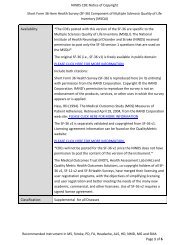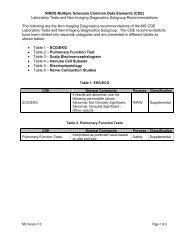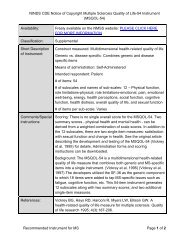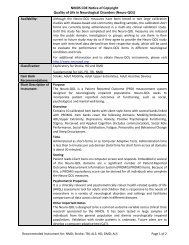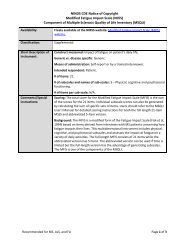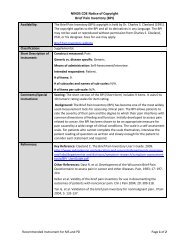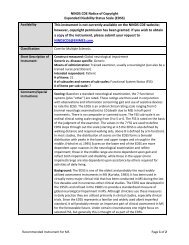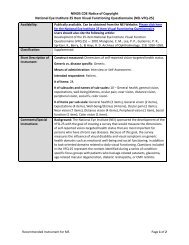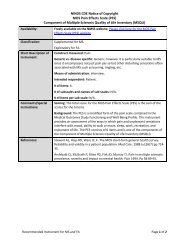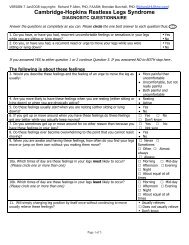NINDS CDE Huntington's Disease Behavioral Psychology Subgroup ...
NINDS CDE Huntington's Disease Behavioral Psychology Subgroup ...
NINDS CDE Huntington's Disease Behavioral Psychology Subgroup ...
Create successful ePaper yourself
Turn your PDF publications into a flip-book with our unique Google optimized e-Paper software.
Description of Cambridge Brain Repair Centre (BRC) HD Sleep Questionnaire forHD Common Data ElementsInstrument Name:Classification:Short Description ofInstrument:ScoringCambridge Brain Repair Centre (BRC) HD Sleep QuestionnaireExploratorySummary/ Overview of Instrument: A newly created instrument specificallydesigned for use with HD patients, this questionnaire was, in part, based onrecent questionnaires used in Parkinson’s disease. It contains 45 questions thatfocus on many aspects of sleep: duration, quality, quality of life, and abnormalsleep behaviors. The authors group the questions into four themed subcategories:quality of sleep, motor activity, abnormal nocturnal behavior and other aspects ofdisturbed sleep. T he authors of this instrument have written comprehensivereviews of the literature in HD and have conducted prior studies of sleep in HD.Construct measured: The total score is conceptualized as a measure of “sleepdisturbance”, but individual questions address a broad range of sleep problemsGeneric vs. disease specific: Developed specifically for Huntington’s diseasepopulations, though the questions do not specifically mention HD such that itcould potentially be studied for possible use in other populations.Intended use of instrument/ purpose of tool: To date the instrument has onlybeen used in one cross-sectional study (primary reference) but the authorssuggest that it might be useful in longitudinal studies. It is primarily proposed as ascreen for sleep disturbance.Means of administration: Paper and pencilLocation of administration: Clinic or homeIntended respondent: Patient# of items: 45# of subscales and names of sub-scales: NoneScoring: A total sleep disturbance score is calculated using a number (but not all)of the questions in the questionnaire. The questions that count toward the totalscore were, in part, selected as they distinguished HD patients from controls inthe primary reference study. A scoring sheet is appended to the original paperwhich identifies the items that count toward the total score as well as the pointsassigned to various options. Scores range from 0-19 and the authors recommendthe following subgroup classifications: normal (0-3), mild (4-6) and s ignificantsleep disturbance (7 and greater) with significant sleep disturbance being theclassification that warrants further investigation and/or treatment when used as ascreening measure in clinical settings.Standardization of scores to a reference population (z scores, T scores, etc):Insufficient researchHD Version 1.0 Page 1 of 3



